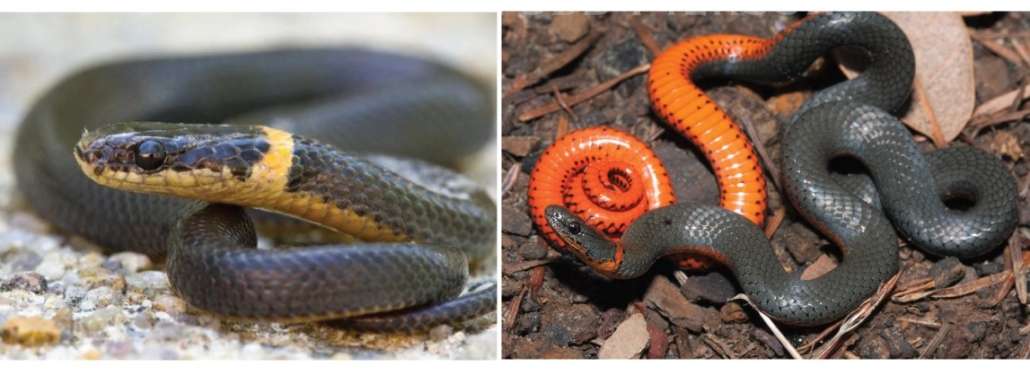SCORES & OUTDOORS: Surprised by a northern ringneck snake
 by Roland D. Hallee
by Roland D. Hallee
A friend of mine, who lives in Sidney, sent a text message with the photo of a snake he found under his wood pile. He said he had never seen one before. Neither have I. The snake was black with a bright yellow ring around its neck. What he found is fairly common.
Diadophis punctatus, commonly known as the ring-necked snake or ringneck snake, is a harmless species of snake found throughout much of the United States, central Mexico, and south-eastern Canada. Ring-necked snakes are secretive, nocturnal snakes, so are rarely seen during the day time. They are best known for their unique defense posture of curling up their tails, exposing their bright red-orange posterior, ventral surface when threatened.
Ring-necked snakes are believed to be fairly abundant throughout most of their range, though no scientific evaluation supports this hypothesis. Scientific research is lacking for the ring-necked snake, and more in-depth investigations are greatly needed.
Ring-necked snakes are fairly similar in morphology throughout much of their distribution. Its dorsal coloration is solid olive, brown, bluish-gray to smoky black, broken only by a distinct yellow, red, or yellow-orange neck band.
Size also varies across the species’ distribution. Typically, adults measure 10–15 inches in length,
Ring-necked snakes have smooth scales with 15–17 scale rows at midbody. Males typically have small tubercles on their scales just anterior to the vent, which are usually absent in females.
Ring-necked snakes usually mate in the spring.
Ring-necked snakes are fairly common throughout much of the United States extending into southeastern Canada and central Mexico. Eastern populations cover the entire Eastern seaboard from the Gulf of Saint Lawrence, in Canada, continuous through the Gulf Coast of Texas. Distribution moves inland into northern Minnesota, continuing diagonally through the U.S. to include all of Iowa, eastern Nebraska, and most of Kansas. In the western U.S., the distribution is significantly less continuous, with spotty, distinct population segments through most of the Pacific Northwest. Populations extend from south-central Washington continuing along the extreme West Coast into Mexico. Population segments extend inland into western Idaho, through southern Nevada, into central Utah, and continuing south through Arizona and central Mexico.
Ring-necked snakes occur in a wide variety of habitats. Preference seems to be determined by areas with abundant cover and denning locations. Northern and western subspecies are found within open woodlands near rocky hillsides, or in wetter environments with abundant cover or woody debris.
Since it is a woodland reptile, it can also commonly be found under wood or scraps. Because of hot weather, they tend to make holes and burrows, or they hide under rocks or any suitable material. They are normally found in flatland forests. Though they prefer to remain away from human-made structures, ring-neck snakes are not afraid to utilize urbanized areas as refuge from predators.
The diet of the ring-necked snake consists primarily of smaller salamanders, earthworms, and slugs, but they also sometimes eat lizards, frogs, and some juvenile snakes of other species. The frequency at which prey species are chosen is dependent on their availability within the habitat. Ring-necked snakes use a combination of constriction and venom to secure their prey. In a study analyzing the dietary habits of this species, age, amount of food consumed, and temperature were conditions that highly affected digestion. The snakes do not have a true venom gland, but they do have a structure called the Duvernoy’s gland derived from the same tissue. The venom is produced in the Duvernoy’s gland located directly behind the eye. It then drains out of an opening at the rear of the maxillary tooth. Ring-necked snakes first strike and then secure the prey using constriction. Next, they maneuver their mouths forward, ensuring the last maxillary tooth punctures the skin and allowing the venom to enter the prey’s tissue. The secretion significantly affects the righting response of the prey. Ring-necked snakes are rarely aggressive toward larger predators, suggesting their venom evolved as a feeding strategy rather than a defense mechanism. Rather than trying to bite a predator, the snake winds up its tail into a corkscrew, exposing its brightly colored belly.
Ring-necked snakes are primarily nocturnal or can be found at twilight, though some day time activity has been observed. Individuals are sometimes found during the day, especially on cloudy days, sunning themselves to gain heat. Yet, most individuals lie directly under surface objects warmed in the sun and use conduction with that object to gain heat. Though ring-necked snakes are highly secretive, they do display some social structure, but the exact social hierarchies have never been evaluated. Many populations have been identified to have large colonies of more than 100 individuals, and some reports indicate some smaller colonies occupy the same microhabitats.
If you should see one, it’s harmless to humans.
Roland’s trivia question of the week:
Who were the Boston Red Sox’ “Gold Dust Twins” in the 1970s?
Responsible journalism is hard work!
It is also expensive!
If you enjoy reading The Town Line and the good news we bring you each week, would you consider a donation to help us continue the work we’re doing?
The Town Line is a 501(c)(3) nonprofit private foundation, and all donations are tax deductible under the Internal Revenue Service code.
To help, please visit our online donation page or mail a check payable to The Town Line, PO Box 89, South China, ME 04358. Your contribution is appreciated!



Leave a Reply
Want to join the discussion?Feel free to contribute!